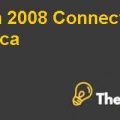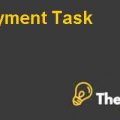Data series analysis using R Case Study Solution
Abstract
The report sets out to evaluate and assess the performance of two stocks i.e. Jhonson and Jhonson and Eli Lilly, using various techniques including normal and logarithmic returns, descriptive statistics, moving averages, ADF Test and ARIMA Model taking weekly prices of the two securities for five years from August 1, 2015 to July 31, 2020 from Yahoo Finance. The report also provide a conclusion about which stock will perform better in next hundred days on the basis of the analysis conducted. Moreover, the report contains charts for moving averages that are constructed using excel along with an analysis in R studio as well. Other plots and results are generated using R studio functions.
Normal and Logarithmic Returns
The return on the investment portfolio is the value of the distribution of return provided to the investors. As a guaranteed predictor of the performance of stock – the expected return formula on the investment portfolio has proven to be the excellent analytical tool that help investorsassess portfolio diversification and risk and forecast probable investment returns.Normal Returns vs Logarithmic Returns are an important factor when looking at your investment portfolio. Many investors who want to maximize their returns have found that a mixture of normal and log returns is most profitable. While there are many advantages to this type of return, there are some risks as well.
The simple return on the investment portfolio is the weighted sum of the simple returns of the portfolio constitutes. One of the most common misconceptionsrelated to the normal returns is that these returns are only applied to certain types of stocks. In actuality, normal returns apply to any type of stock including those that have had a few years of steady growth. There is no age limit to the category of stocks used in this analysis. The normal return could be used to evaluate the profitability and the performanceof the stock.
Log returns or continuously compounded returns, on the other hand, for the long period of time is the sum of the log returns of the partitions of the time period. The log returns relate directly to how long it will take for one dollar's worth of financial asset to grow to a hundred dollars. The longer the time frame you are looking at, the lower the risk. There is no minimum amount of time you have to invest in order to reach the maximum profit(Miskolczi, 2019).
In addition to this, it is pertinent to note that the two period log returns is identical to the sum of log return of each period. With core consideration of getting the n-period log returns, one could simply add log returns for the consecutive single period whereas on the other hand, the simple returns on the financial assets such as portfolio or investment is not time addictive.Furthermore, the log returns is comparatively good than the simple return on account of the fact that the log return approximate the discrete return anyway for the shorter period of time i.e. on daily basis. There are number of benefits of using the log returns such as; mathematical ease, approximate raw-log equality, time-addictiveness, and log normality. One of the most common difference between simple return and log return is the features of the asset-addictivity and time- addictivity. The simple returns, in comparison to the log return are asset addictive and it could be used where portfolio returns have to be calculated and portfolio are formed because of its asset-addictive property. In contradiction to the asset-addictive feature of the simple returns, the log returns are time-addictive; the log returns over the n period is merely the significant difference in log between final and initial periods, providing an advantage on account of the reason that the sum of the normally distributed variable is also normally distributed which is the negative feature of the simple returns on the financial assets as probability theory states that the product of normally distributed variable is not normally distributed............................
This is just a sample partical work. Please place the order on the website to get your own originally done case solution.











